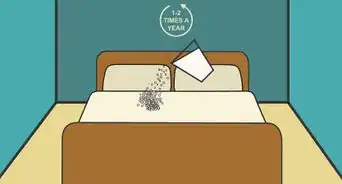This article was co-authored by Ashley Moon, MA. Ashley Moon is the Founder and CEO of Creatively Neat, a virtual organizing and life coaching business based in Los Angeles, California. In addition to helping people organize their best life, she has a fabulous team of organizers ready to de-clutter your home or business. Ashley hosts workshops and speaking engagements at various venues and festivals. She has trained with Coach Approach and Heart Core for organizing and business coaching respectively. She has an MA in Human Development and Social Change from Pacific Oaks College.
This article has been viewed 151,049 times.
Animals both small and large love to make their way under your bed! By blocking off this space, you can prevent your pets from going down under. Two simple options for blocking off under your bed include squeezing snug-fitting items under your bed, and creating a barrier with pipe insulation and zip ties.
Steps
Placing Items Under the Bed
-
1Use storage containers if you can spend a bit of money. Go shopping at your local big box store, storage container specialty store, or online to find under-the-bed storage containers that closely match the size of the negative space. Wiggle the containers into the space under your bed.
- Add heavy items to the containers to prevent them from sliding around.
- Add labels to the outside of the containers so you know what’s inside them.
- Use these containers to store seasonal clothes or items you don’t use on a daily basis.
-
2Stack books under your bed if you have a lot of them. Gather some thick and heavy books that you won’t need to use for a while. Create stacks of books that will fit under your bed. The average book is 9 inches (23 cm) tall and the average bed is 80 inches (200 cm) long. This means you’ll need about 8 stacks of books on both sides of your bed, plus more along the foot of your bed. Slide the stacks in one at a time.
- The number of books in each stack will vary depending on the height of the space under your bed, and the thickness of your books.
Advertisement -
3Block your bed with cardboard boxes for a low-budget choice. Shoe boxes are often a great size for this, but you might use food boxes (e.g., cases of almond milk or raisins) or boxes from items you’ve ordered online. Line the boxes up against the sides of your bed, then wiggle them underneath.
- Ask around at a local shoe store to see if they have extra boxes.
- Place heavy items inside the boxes to prevent them from sliding around.
Using Pipe Insulation Secured with Zip Ties
-
1Figure out how many “levels” of pipe insulation you’ll use. Use a tape measure to determine the height of the negative space under your bed. You will be using 2 inches (5.1 cm) thick pipe insulation for this project.[1]
- If the height of the space is close to 2 inches (5.1 cm), you only need 1 “level.” If it is more like 4 inches (10 cm), you need 2. If it is closer to 6 inches (15 cm) you need 3.
- Pipe insulation can be purchased at home improvement stores.
-
2Determine the number of pipe insulation tubes you need. For a standard queen or king-size bed, you will need 5 pieces of pipe insulation (76 by 2 inches (193.0 cm × 5.1 cm) each) for 1 level (1 piece for each side, plus an extra piece to create extensions). If you will be using 2 levels, you will need 9 pieces. If you’ll be using 3 levels, you’ll need 13 pieces.[2]
- If your bed is significantly larger than a standard queen or king, you will need more pipe insulation.
- A standard twin bed is 39 inches (99 cm) wide by 80 inches (200 cm) long. For a bed this size, you can use just 4 pieces per level.
-
3Create pieces 4 inches (10 cm) long to extend tube lengths. Grab one of your pieces of pipe insulation and measure an 4 inches (10 cm) segment using your tape measure. Cut this section off using sharp scissors. Repeat so that you now have 2 4 inches (10 cm) long extender pieces.[3]
- Most standard beds are 80 inches (200 cm) in length.
- Pipe insulation comes in pieces {{convert}76|in|cm}} long, so you need to add an extra 4 inches (10 cm) for most beds.
- If your bed is longer than 80 inches (200 cm), your extension pieces will need to be longer.
- If you will be installing 2 levels, you will need 4 extender pieces. If you will be installing 3, you’ll need 6.
-
4Create pieces 80 inches (200 cm) long. Take a piece of pipe insulation (76 inches (190 cm) long), and pierce both ends of the tube with an embroidery needle on the front and back (so that it now contains 4 holes). Repeat this action on 1 of your extender pieces (4 inches (10 cm)). Place the full-length piece and the extender side-by-side. Use 2 zip ties (1 in the front and 1 in the back) to attach the pieces to one another.[4]
- If you are installing 1 level, you need to create 2 pieces that are 80 inches (200 cm). For 2 levels, you’ll need 4. For 3 levels you’ll need 6.
- Use scissors to trim the excess plastic from the tightened zip tie.
-
5Trim tubes for the width of the bed. Line a piece of pipe insulation up with the bottom of your bed. Use sharp scissors to cut your insulation to be approximately the width of your bed. It does not need to be an exact measurement. For 1 level you will need 2 pieces this size. For 2 levels, 4, and for 3 levels 6.
- If you have a king-size bed, you should not need to trim the insulation.
- For a queen-size bed, you will be removing about 16 inches (41 cm).
- For a twin bed, you will be removing around 37 inches (94 cm).
-
6Poke holes in the ends of your pieces with an embroidery needle. Pierce the ends of every piece of pipe insulation you are going to use (on the front and back) with an embroidery needle. Make the holes wide enough for a zip tie to fit through.
-
7Secure the pipe insulation to the legs of your bed using zip ties. Lay 1 piece of pipe insulation on each side of your bed (placing the long pieces along the length and the short pieces along the width). Feed a zip tie through each set of holes. Slide the zip tie around the leg of the bed, slip it through the catch and tighten it. Repeat on every bed leg.[5]
- Use scissors to trim the excess plastic from the tightened zip tie.
-
8Add additional levels (optional). Push the current level up as high as it will go. Lay another round of pipe insulation all around the bed (placing longer piece along the length and short pieces along the width). Make sure that all these pieces have hole in them for zip ties. Feed a zip tie into each hole, and affix the pipe insulation under the level you already attached.
- If you will create a third level, push the second level up and add it underneath.
Things You’ll Need
- Plastic storage bins
- Cardboard boxes
- Books
- Tape measure
- Sharp scissors
- Zip ties
- Embroidery needle
- Pipe insulation
References
- ↑ http://www.rachelsnest.com/2013/07/diy-under-sofa-toy-blocker.html
- ↑ http://www.rachelsnest.com/2013/07/diy-under-sofa-toy-blocker.html
- ↑ https://www.youtube.com/watch?v=HfQNkfD21Oo&feature=youtu.be&t=95
- ↑ https://www.youtube.com/watch?v=HfQNkfD21Oo&feature=youtu.be&t=127
- ↑ https://www.youtube.com/watch?v=HfQNkfD21Oo&feature=youtu.be&t=127
About This Article
To block off space under the bed, fill the space with items like books, shoeboxes, or storage containers to utilize room. For a more sturdy option, build a gate with pipe insulation and zip ties. To do this, measure the length and width of the space and purchase enough insulation to fit. Cut it to size, poke holes in the end with an embroidery needle, and secure it to your bedposts with zip ties. To learn how to trim insulation to fit your bed size, read on!




































































